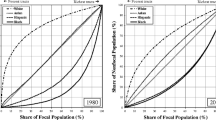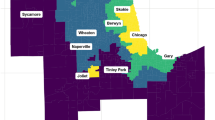Abstract
Massey and Denton’s concept of hypersegregation describes how multiple and distinct forms of black-white segregation lead to high levels of black-white stratification. However, numerous studies assessing the association between segregation and racial stratification applied only one or two dimensions of segregation, neglecting how multiple forms of segregation combine to potentially exacerbate socioeconomic disparities between blacks and whites. We address this by using data from the U.S. Census from 1980 to 2010 and data from the American Community Survey from 2012 to 2016 to assess trajectories for black-white disparities in educational attainment, employment, and neighborhood poverty between metropolitan areas with hypersegregation and black-white segregation, as measured by the dissimilarity index. Using a time-varying measure of segregation types, our results indicate that in some cases, hypersegregated metropolitan areas have been associated with larger black-white socioeconomic disparities beyond those found in metropolitan areas that are highly segregated in terms of dissimilarity but are not hypersegregated. However, the contrasts in black-white socioeconomic inequality between hypersegregated metropolitan areas and those with high segregation largely diminish by the 2012 to 2016 observation.


Similar content being viewed by others
Notes
Prior delineations, such as standard metropolitan statistical areas (MSAs), for 1980 employed New England Counties and Town Areas as the subunits for states in New England.
We omit the Hartford-West Hartford-East Hartford, CT, and Cape Coral, FL, metropolitan areas because of invalid data for the socioeconomic measures in these areas.
For a detailed description of the five dimensions of segregation and equations of each, see the online appendix.
We set the year covariate to 2016 for the 2012–2016 ACS observations. We also tested 2012 as the value for this time point and found no substantive difference in results.
See the online appendix for supplemental models including these demographic characteristics.
See the online appendix for supplemental models of the all metropolitan area panel with and without metropolitan demographic characteristics.
The online appendix contains additional descriptive tables, including tables for all metropolitan areas by study inclusion and year-specific segregation types; summary statistics describing focal measures of the study’s analyses by sample; and average segregation levels by segregation type, year, and sample.
References
Allard, S. W. (2017). Places in need: The changing geography of poverty. New York, NY: Russell Sage Foundation.
Bell, W. (1954). A probability model for the measurement of ecological segregation. Social Forces, 32, 357–364.
Chetty, R., Hendren, N., & Katz, L. F. (2016). The effects of exposure to better neighborhoods on children: New evidence from the Moving to Opportunity experiment. American Economic Review, 106, 855–902.
Clear, T. R. (2007). Imprisoning communities: How mass incarceration makes disadvantaged neighborhoods worse. New York, NY: Oxford University Press.
Crowder, K., & Downey, L. (2010). Interneighborhood migration, race, and environmental hazards: Modeling microlevel processes of environmental inequality. American Journal of Sociology, 115, 1110–1149.
Farrell, C. R., & Lee, B. A. (2011). Racial diversity and change in metropolitan neighborhoods. Social Science Research, 40, 1108–1123.
Frankenberg, E., Lee, C., & Orfield, G. (2003). A multiracial society with segregated schools: Are we losing the dream? (Working paper of The Civil Rights Project). Cambridge, MA: Harvard University, Civil Rights Project.
GeoLytics. (2013). CensusCD Neighborhood Change Database tract data from 1970–2010. Somerville, NJ: GeoLytics. Retrieved from https://www.geolytics.com/USCensus,Neighborhood-Change-Database-1970-2000,Data,Features,Products.asp
Iceland, J., & Wilkes, R. (2006). Does socioeconomic status matter? Race, class, and residential segregation. Social Problems, 53, 248–273.
Kneebone, E., & Holmes, N. (2015). The growing distance between people and jobs in metropolitan America (Metropolitan Opportunity Series report). Washington, DC: Brookings Institution, Metropolitan Policy Program.
Lipsitz, G., & Oliver, M. L. (2010). Integration, segregation, and the racial wealth gap. In C. Hartman & G. D. Squires (Eds.), The integration debate: Competing futures for American cities (pp. 153–167). New York, NY: Routledge.
Logan, J. R., & Stults, B. J. (2011). The persistence of segregation in the metropolis: New findings from the 2010 census (US2010 Project). Providence, RI: Brown University.
Logan, J. R., & Zhang, C. (2010). Global neighborhoods: New pathways to diversity and separation. American Journal of Sociology, 115, 1069–1109.
Logan, J. R., & Zhang, W. (2011). Global neighborhoods: New evidence from Census 2010 (US2010 Project). Providence, RI: Brown University.
Manson, S., Schroeder, J., Van Riper, D., & Ruggles, S. (2018). IPUMS National Historical Geographic Information System: Version 13.0 [Database]. Minneapolis: University of Minnesota. https://doi.org/10.18128/D050.V13.0
Massey, D. S. (2015). The legacy of the 1968 Fair Housing Act. Sociological Forum, 30(Suppl. 1), 571–588.
Massey, D. S., & Denton, N. A. (1988). The dimensions of residential segregation. Social Forces, 67, 281–315.
Massey, D. S., & Denton, N. A. (1989). Hypersegregation in U.S. metropolitan areas: Black and Hispanic segregation along five dimensions. Demography, 26, 373–391.
Massey, D. S., & Denton, N. A. (1993). American apartheid: Segregation and the making of the underclass. Cambridge, MA: Harvard University Press.
Massey, D. S., & Tannen, J. (2015). A research note on trends in black hypersegregation. Demography, 52, 1025–1034.
Massey, D. S., & Tannen, J. (2016). Segregation, race, and the social worlds of rich and poor. In I. Kirsch & H. Braun (Eds.), The dynamics of opportunity in America: Evidence and perspectives (pp. 13–33). New York, NY: Springer.
Napierala, J., & Denton, N. (2017). Measuring residential segregation with the ACS: How the margin of error affects the dissimilarity index. Demography, 54, 285–309.
Peterson, R. D., & Krivo, L. J. (2010). Divergent social worlds: Neighborhood crime and the racial-spatial divide. New York, NY: Russell Sage Foundation.
Pettigrew, T. F. (1979). Racial change and social policy. Annals of the American Academy of Political and Social Science, 441, 114–131.
Quillian, L. (2012). Segregation and poverty concentration: The role of three segregations. American Sociological Review, 77, 354–379.
Quillian, L. (2014). Does segregation create winners and losers? Residential segregation and inequality in educational attainment. Social Problems, 61, 402–426.
Roscigno, V. J., Karafin, D. L., & Tester, G. (2009). The complexities and processes of racial housing discrimination. Social Problems, 56, 49–69.
Rothstein, R. (2017). The color of law: A forgotten history of how our government segregated America. New York, NY: Liveright.
Roux, A. V. D., & Mair, C. (2010). Neighborhoods and health. Annals of the New York Academy of Sciences, 1186, 125–145.
Rugh, J. S., & Massey, D. S. (2010). Racial segregation and the American foreclosure crisis. American Sociological Review, 75, 629–651.
Sampson, R. J., Sharkey, P., & Raudenbush, S. W. (2008). Durable effects of concentrated disadvantage on verbal ability among African-American children. Proceedings of the National Academy of Sciences, 105, 845–852.
Schuman, H. (1997). Racial attitudes in America: Trends and interpretations. Cambridge, MA: Harvard University Press.
Schuman, H., & Bobo, L. (1988). Survey-based experiments on white racial attitudes toward residential integration. American Journal of Sociology, 94, 273–299.
Sharkey, P. (2013). Stuck in place: Urban neighborhoods and the end of progress toward racial equality. Chicago, IL: University of Chicago Press.
Sharkey, P. (2014). Spatial segmentation and the black middle class. American Journal of Sociology, 119, 903–954.
Sharkey, P., & Sampson, R. J. (2010). Destination effects: Residential mobility and trajectories of adolescent violence in a stratified metropolis. Criminology, 48, 639–681.
South, S. J., Pais, J., & Crowder, K. (2011). Metropolitan influences on migration into poor and nonpoor neighborhoods. Social Science Research, 40, 950–964.
Taylor, P., Morin, R., Cohn, D., & Wang, W. (2008). Americans say they like diverse communities; Election, census trends suggest otherwise (Pew Research Center Social & Demographic Trends report). Washington, DC: Pew Research Center.
Turner, M. A., Santos, R., Levy, D. K., Wissoker, D., Aranda, C., Pitingolo, R., & Urban Institute. (2013). Housing discrimination against racial and ethnic minorities 2012. Washington, DC: U.S. Department of Housing and Urban Development, Office of Policy Development and Research.
vonLockette, N. D. (2010). The impact of metropolitan residential segregation on the employment chances of blacks and whites in the United States. City & Community, 9, 256–273.
White, M. J. (1983). The measurement of spatial segregation. American Journal of Sociology, 88, 1008–1018.
Wilkes, R., & Iceland, J. (2004). Hypersegregation in the twenty-first century. Demography, 41, 23–36.
Wilson, W. J. (1987). The truly disadvantaged: The inner city, the underclass, and public policy. Chicago, IL: University of Chicago Press.
Acknowledgments
A preliminary draft of this article was presented in Denver at the annual meetings of the Population Association of America, April 28, 2018. Partial support for this research came from a Eunice Kennedy Shriver National Institute of Child Health and Human Development research infrastructure grant, P2C HD042828, to the Center for Studies in Demography & Ecology at the University of Washington. We thank Stew Tolnay, Jerry Herting, Matt Hall, the Demography editors, and the four anonymous Demography reviewers for their helpful comments on earlier versions of this article.
Author information
Authors and Affiliations
Corresponding author
Additional information
Publisher’s Note
Springer Nature remains neutral with regard to jurisdictional claims in published maps and institutional affiliations.
Electronic supplementary material
ESM 1
(PDF 182 kb)
Rights and permissions
About this article
Cite this article
Hess, C., Gabriel, R., Leibbrand, C. et al. Does Hypersegregation Matter for Black-White Socioeconomic Disparities?. Demography 56, 2169–2191 (2019). https://doi.org/10.1007/s13524-019-00825-y
Published:
Issue Date:
DOI: https://doi.org/10.1007/s13524-019-00825-y




